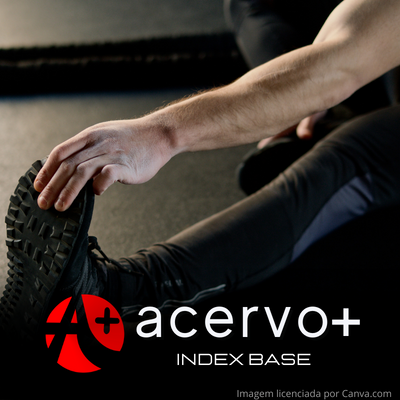Análise de métodos de alongamentos para os isquiotibiais: uma revisão sistemática
##plugins.themes.bootstrap3.article.main##
Resumo
Objetivo: Identificar através de evidências científicas qual método de alongamento é mais eficaz para promover a flexibilidade dos isquiotibiais. Métodos: Foi realizada uma revisão sistemática de literatura dos últimos 10 anos nas bases de dados das plataformas PubMed, LILACS, Scielo, PEDro e MedLine. Resultados: Após a busca nos bancos de dados foram encontrados 196 estudos nas plataformas estudadas. Foram incluídos 11 estudos para a síntese do estudo, no qual possuía indivíduos de ambos os sexos com faixa etária de 18 a 60 anos. De acordo com avaliação de qualidade metodológica, 9 estudos apresentaram pontuação acima de 6 pontos, considerados assim, de grande potencial de evidência. Considerações finais: Apesar de não ter sido possível realizar uma comparação totalmente conclusiva devido às diversas limitações, foi observado que todos os alongamentos foram capazes de desenvolver flexibilidade nos isquiotibiais, entretanto os alongamentos FNP prevaleceram sendo mais eficazes desenvolvendo maiores ganhos de flexibilidade dos isquiotibiais.
##plugins.themes.bootstrap3.article.details##
Copyright © | Todos os direitos reservados.
A revista detém os direitos autorais exclusivos de publicação deste artigo nos termos da lei 9610/98.
Reprodução parcial
É livre o uso de partes do texto, figuras e questionário do artigo, sendo obrigatória a citação dos autores e revista.
Reprodução total
É expressamente proibida, devendo ser autorizada pela revista.
Referências
2. BORGES KCT, et al. Avaliação da dor lombar correlacionada ao encurtamento dos isquiotibiais em docentes de uma instituição de Ensino Superior. Rev Soc Bras Clin Med, 2017; 15(1): 21-6.
3. BRITO CN, TRINDADE K. Efeitos de duas técnicas de alongamentos no ganho de flexibilidade de cadeia posterior em mulheres sedentárias. Fisioterapia Brasil, 2020; 21(1): 3-7.
4. CASTELLOTE-CABALLERO Y, et al. Immediate Effects of Neurodynamic Sliding versus Muscle Stretching on Hamstring Flexibility in Subjects with Short Hamstring Syndrome. J Sports Med (Hindawi Publ Corp), 2014; 2014: 127471.
5. DEMOULIN C, et al. A comparison of two stretching programs for hamstring muscles: A randomized controlled assessor-blinded study. Physiotherapy Theory and Practice An International Journal of Physiotherapy, 2016; 32(1): 53-62.
6. FAIGENBAUM AD, et al. Dynamic warm-up protocols, with and without a weighted vest, and fitness performance in high school female athletes. J Athl Train, 2006; 41(4): 357–363.
7. GRAEFF GK, ROBERTO MS. Anatomia do sistema locomotor e atlas fotográfico do sistema esquelético. UPF editora; 2013.
8. HOLZMAN CW, PETER SM. Increasing muscle extensibility: a matter of increasing length or modifying sensation?. Physical Therapy, 2010; 90(3): 438–449.
9. IWATA M, et al. Dynamic Stretching Has Sustained Effects on Range of Motion and Passive Stiffness of the Hamstring Muscles. Journal of Sports Science and Med, 2019; 18(1): 13-20.
10. JEONG ED, et al. Immediate effects of static and proprioceptive neuromuscular facilitation stretching of hamstring muscles on straight leg raise, craniovertebral angle, and cervical spine range of motion in neck pain patients with hamstring tightness: A prospective randomized controlled trial. J Back Musculoskelet Rehabil., 2022; 35(2): 429-438.
11. LÓPEZ-MIÑARRO PA, et al. Acute effects of hamstring stretching on sagittal spinal curvatures and pelvic tilt. J Hum Kinet., 201; 31: 69-78.
12. MASOOD K, et al. Comparison between dynamic oscillatory stretch technique and static stretching in reduced hamstring flexibility in healthy population: A single blind randomized control trial. JPak Med Assoc., 2020; 0(11): 1908-1912.
13. MCHUGH MP, et al. The role of neural tension in hamstring flexibility. Scand J Med Sci Sports, 2012; 22(2): 164-9.
14. MORCELLI MH, et al. Comparação do alongamento estático, balístico e contrair-relaxar nos músculos isquiotibiais. Fisioterapia e Pesquisa, 2013; 20(3): 244-249.
15. MUYOR JM, et al. Effect of stretching program in an industrial workplace on hamstring flexibility and sagittal spinal posture of adult women workers: a randomized controlled trial. J Back Musculoskelet Rehabil., 2012; 25(3): 161-169.
16. NISHIKAWA Y, et al. Immediate effect of passive and active stretching on hamstrings flexibility: a single-blinded randomized control trial. J Phys Ther Sci., 2015; 27(10): 3167-70.
17. PARK S e LIM W. Effects of proprioceptive neuromuscular facilitation stretching at low-intensities with standing toe touch on developing and maintaining hamstring flexibility. J Bodyw Mov Ther., 2020; 24(4): 561-567.
18. REIS FJJ, MACEDO AR. Influence of hamstring tightness in pelvic, lumbar and trunk range of motion in low back pain and asymptomatic volunteers during forward bending. Asian Spine, 2015; 9(4): 535-540.
19. SADLER SG, et al. Restriction in lateral bending range of motion, lumbar lordosis, and hamstring flexibility predicts the development of low back pain: A systematic review of prospective cohort studies. BMC Musculoskeletal Disorders , 2017; 18(1): 179.
20. SIMIC L, et al. Does pre-exercise static strecthing inhibit maximal muscular performance? A meta-analytical review. Scand J Med Sci Sports, 2013; 23(2): 131-148.
21. TAVELLA NM, et al. Assessment and comparison of the effects of two techniques on hamstring flexibility. Fisioter mov, 2014; 27(4): 583-589.

